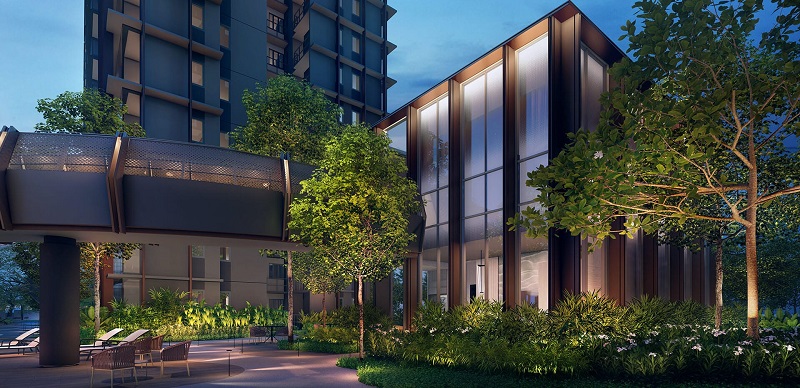The Continuum Architecture: Blending Modern Design with Katong’s Timeless Heritage

Where the Future Meets the Past
In a city that constantly reinvents itself, The Continuum stands out for one simple reason — it remembers where it came from.
This freehold District 15 gem isn’t just another high-rise complex. It’s a masterful fusion of modern architecture and Katong’s historic soul.
Every curve, facade, and walkway tells a story — of how Singapore’s future can coexist beautifully with its past.
A Dual-Plot Vision That Breaks Boundaries
The Continuum’s architectural concept begins with a daring idea — two connected plots, one unified identity.
Linked by an elegant sky bridge, these two parcels aren’t merely divided pieces of land; they’re a deliberate statement about connectivity and flow.
The design allows light, air, and people to move freely between both zones — creating a sense of spatial openness rarely seen in urban developments today.
It’s a smart architectural move that doubles functionality without feeling overcrowded.
Design Philosophy: Timelessness Over Trend
While many modern condos chase trendy exteriors and glass-heavy facades, The Continuum’s architects went for something deeper — timeless design with local context.
Instead of sterile minimalism, you get warm tones, organic materials, and textural variety inspired by Katong’s shophouses and colonial homes.
This isn’t nostalgia — it’s evolution.
It respects the charm of the old streets while framing it within clean, futuristic lines. The result?
A structure that feels instantly familiar yet impressively modern.
Aesthetic Harmony: Glass, Steel & Heritage
From a distance, The Continuum commands attention with its sleek symmetry — towers rising with rhythm, punctuated by subtle curves and layered balconies.
But step closer, and you’ll notice how the architects softened the urban edge with details borrowed from Katong’s old soul:
- Perforated metal screens inspired by Peranakan motifs.
- Earth-toned panels mirroring shophouse palettes.
- Lush vertical greenery echoing the tropical charm of the East Coast.
It’s this play between glass, steel, and history that gives the development its unique DNA.
The Sky Bridge: Connection with Purpose
At the heart of The Continuum’s architectural story is its sky bridge — a literal and symbolic link between the two plots.
It’s not just a walkway; it’s a living space.
Residents use it as:
- A scenic jogging path at sunrise.
- A community link for social interactions.
- A viewing deck with skyline and sea glimpses.
Architecturally, it also enhances air circulation, increases accessibility, and forms a distinct visual landmark visible from afar.
It’s functional artistry in motion — simple, striking, and memorable.
Sustainability at the Core
Modern design isn’t just about aesthetics anymore — it’s about responsibility.
The Continuum integrates sustainable architecture through:
- Cross-ventilated corridors that reduce energy consumption.
- Sun-shading fins that lower heat gain naturally.
- Rainwater harvesting systems supporting landscape irrigation.
- Energy-efficient lighting throughout common areas.
The architecture doesn’t shout “green”; it simply is green — built for long-term livability, not short-term buzzwords.
Spatial Intelligence: Flow and Function
Every inch of The Continuum’s layout was mapped out to enhance human experience.
Instead of rigid blocks, the towers are slightly angled to catch natural wind and maximize privacy.
Walkways are wide, naturally lit, and flanked by greenery. Lobbies open directly into landscaped courtyards.
From the pool decks to sky gardens, every level transitions effortlessly — no dead corners, no visual clutter.
This kind of fluidity is the hallmark of good architecture: spaces that feel right even before you notice why.
Human-Scaled Design
Despite its modern scale, The Continuum maintains a sense of intimacy.
Ground-level structures — like the Heritage Clubhouse — are kept low and detailed to preserve a human scale.
Instead of intimidating glass towers, you get approachable facades with soft lighting, recessed balconies, and natural materials.
It’s luxury with empathy — design that respects both form and feeling.
Integration of the Heritage House
A standout architectural move is the restoration and repurposing of the conserved heritage house on-site.
Rather than demolish it, the developers revived it as part of the estate — now serving as a cultural and communal hub.
This fusion of old and new gives The Continuum something few developments can claim — authenticity.
It’s proof that architecture can evolve without erasing history.
Light, Air, and Space: The Unseen Architects
The Continuum’s design uses three invisible elements to perfection: light, air, and space.
- Natural light floods through full-height windows, reducing dependence on artificial lighting.
- Ventilation corridors keep air fresh and temperatures comfortable year-round.
- Open-plan interiors ensure every home feels bright and breathable.
It’s the kind of design that looks good but feels even better to live in — modern architecture done with emotional intelligence.
The Katong Connection
You can’t talk about The Continuum’s architecture without mentioning Katong — the neighbourhood that shaped it.
Katong has always been a mix of cultural layers: Peranakan heritage, colonial influences, and coastal charm.
The Continuum mirrors that diversity through design contrasts — sleek glass towers grounded by earthy textures, structured geometry softened by natural landscaping.
It’s like a visual conversation between generations — the past whispering to the future.
Architectural Identity in the East
In a region where developments often look interchangeable, The Continuum brings identity back.
It doesn’t try to mimic Marina Bay or Orchard. It defines its own brand of East Coast sophistication — relaxed yet refined.
That’s what architecture should do: speak for its location, not compete with it.
The Continuum’s visual language — subtle, balanced, and bold — captures exactly that.
Future-Proof Design
Architecture is meaningless if it can’t age well.
That’s why The Continuum’s materials and layouts were chosen for longevity:
- Low-maintenance composite panels instead of easily weathered cladding.
- Modular internal layouts adaptable to future renovation needs.
- Smart building systems ready for IoT upgrades.
This is architecture that doesn’t just serve today — it anticipates tomorrow.
Final Thoughts
The Continuum isn’t another architectural statement screaming for attention.
It’s a quiet revolution — a reminder that true design isn’t about height or hype but harmony.
By blending heritage aesthetics with contemporary precision, it bridges generations — proving that the future of Singapore architecture doesn’t have to abandon its roots.
When glass meets shophouse charm, when history finds its place in tomorrow’s skyline — that’s where The Continuum stands.
A masterpiece built not just to be seen, but to be felt.

